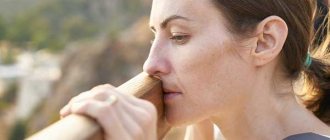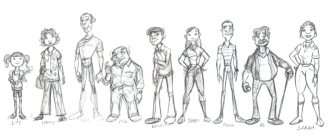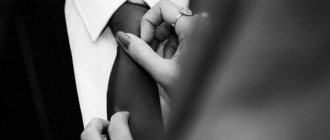Normosthenic is one of the types of typology of physiques and characters proposed by Kretschmer. Of all the other body types, the normosthenic body type is evolutionarily the best type for survival in conditions of physical reality. Usually these are strong, vital, athletic people. Their inherent strength is manifested not only in the somatic plane, they are quite mentally stable, have a social orientation, are extroverted, can show persistence in their chosen work and leadership qualities, and without much stress, representing natural traits.
Who is a normosthenic?
Normosthenic is one of the body types and character typologies proposed by Kretschmer. Of all other body types, the normosthenic type is the evolutionarily best type for survival in physical reality. These are, as a rule, strong, resilient people with an athletic build. Their innate strength is not only somatic, they are quite mentally stable, have a social orientation, are extroverted, can show persistence in their chosen task and leadership qualities, and do this without much effort, representing natural qualities.
It is quite easy to recognize a normostenric person even in a passer-by - they are dexterous and athletically built. They are tall, proportionally built and full of physical strength. Normosthenics rarely go unnoticed because they do not have anxiety or low self-esteem. Their gait is fast and energetic, their posture is always perfect, their facial expression is clear and clear, and their voice is loud and confident. In principle, confidence shines through in their every gesture, but observing the need to behave quietly and inconspicuously, speak calmly, and not attract unnecessary attention to yourself will be quite difficult.
Such a developed physical part of a person makes him capable of performing almost any physical work or withstanding prolonged stress. These are those who love to go to the gym at the end of the work week, getting real pleasure from working on their body. The hidden need for movement forces them to choose active types of recreation, preferring walking instead of the subway or rock climbing instead of sunbathing by the pool. The increased need for activity also has another side - the need to constantly replenish energy reserves, so the metabolism of a normosthenic person is somewhat accelerated, and if, contrary to his nature, he sits all day, he will soon face obesity. In such a situation, a normosthenic person can lose weight by either reviewing their lifestyle and introducing more physical activity, or following a strict diet.
Since a person cannot change his appetite, he must regulate his food intake and exercise. A normosthenic person who does not comply with these parameters risks not only saying goodbye to a fairly slim and beautiful figure, but also getting health problems. The weak points of a normosthenic are the heart, blood vessels and skin, the organ that removes toxins from the body. Recommendations for nutritional balance include minimizing carbohydrates and eating more protein foods. The ideal is to eat three healthy meals a day, with snacks consisting of only fruits or vegetables.
In terms of training, a normosthenic must combine all types of training so that the body, designed for athletic and strength performance, feels development and pleasure from movement. If training on simulators seems boring, an alternative could be scuba diving, kayaking, hiking, piloting a motorcycle - all active recreation options, as well as options with a higher level of extremeness, are quite possible. The normosthenic type is adapted to successfully cope with such overloads that are inaccessible to the asthenic type.
Normosthenic is a special type of human character and physique.
Development and work on oneself asthenics
Many consider the main problem of asthenics exclusively with thinness, although only a doctor can advise an asthenic to gain weight for medical reasons.
More significant is the correction of the emotional palette and features of building your own life. An important point that combines concern for mental and physical well-being is sport. Moreover, it is better for asthenics to choose active, paired, competitive sports or various styles of wrestling. Private yoga classes with an instructor can help you relax and calm your nervous system, but the most important thing is to learn how to control your aggressive outbursts and work with suppressed emotions. Wrestling, running, athletics are places where you can safely release accumulated tension, and therefore protect yourself and your loved ones from random outbursts of anger due to the accumulation of tension.
The more tension an asthenic person can relieve in a safe way, the more internal resources appear, since the psyche spends more energy on restraining itself than on reacting. Everything that could not be realized through active actions should continue to be removed through relaxation. Alcohol and drugs are contraindicated here, since they relax the muscles, but activate the nervous system, causing it to become even more inflated. So after a good workout, massage or swimming is recommended.
You can establish social interaction by setting yourself the goal of meeting a couple of new people every day (or at least every Saturday). The main thing here is not collecting ticks, but trying to find a way of communication in which you feel maximum comfort and naturalness of the situation and your presence in it.
The longest process will be working on your inner feeling and perception of yourself - self-esteem, self-criticism, expectations and demands from others, and so on. Such categories can be dealt with over the course of several months, and to make the process more effective and faster, it is better to seek the advice of a psychotherapist. Stabilization of the emotional background is one of the primary tasks that an asthenic person should work on. The ability to control your emotions and expectations, stop excessive reflection and self-deprecation.
The ability to find sources of energy and fullness will help you not become exhausted at such a rate. For some it will be their own creativity, and for others it will be an opportunity for dosed communication with people. Saving mental resources and their timely replenishment is an algorithm necessary for every asthenic.
Text: Olga Kim
German psychologist and scientist Ernst Kretschmer studied a huge number of people, measuring both their physique and character. In the end, he came to the conclusion that there is a clear relationship between a person’s psychotype and the makeup of his temperament and emotionality. Kretschmer identified three main human psychotypes, one of which is asthenic. What characterizes asthenic?
The nature of this personality type
The characteristics of a person depend on his somatic condition and the type of organization of the body. The sensitivity and mobility of the nervous system, the ability to transform stressful experiences through the body's reaction, the influence of hormonal levels - all this physically determines the temperamental and personal characteristics of normosthenics.
Thus, for the character of a normosthenic person, great importance is usually attached to the emotional sphere, which will be the leading motive or an important companion of any activity. The love of physical activity and the ability to express on a physical level allow negative emotions to circulate freely, so such people may appear overly aggressive, although they simply do not suppress negative or protest feelings. But sometimes emotional capture plays against normosthenics, increasing the risk of a hypertensive crisis or heart attack. Accustomed to unleashing an aggressive whirlwind without stopping, a normosthenic runs the risk of rendering his own nervous system unusable, and without much help from others. The strength of somatic and psychological parameters in most cases causes people to give up or simply leave.
They also have an innate appetite for risk, which is a consequence of their confidence in their own physical strength. Note that the more physically helpless a person is, the less he will take risks in other matters, while a stable position at least in the body gives more confidence. Such self-confidence sometimes borders on the desire to solve many problems by dominating or showing strength. This is usually typical for normosthenics whose level of intelligence is at an average level, or who had deficiencies in socialization. At a high level of development, this tendency to take risks is transformed into excellent qualities of managers and organizers, those who are able to change the current state of affairs and bring not only their lives, but also the lives of other people to a new level. The ability to take risks, accompanied by a high level of responsibility for every decision, makes a normosthenic a leader, even if he does not document his position.
These people love to be the center of attention. In attractive versions, this is achieved thanks to their charm, sense of humor, oratorical and leadership qualities; in negative versions, their desire for attention can lead to loud talking and sarcastic remarks. They love speaking in public or being among crowds. An unfamiliar audience does not frighten, but on the contrary, stimulates normosthenics, giving them a surge of energy and interest, new ideas and concepts.
The desire to compete is present everywhere, from the choice of sport to the approach to work.
This means that a normosthenic is more interested in the moment of victory in competition than in achieving a specific goal. Sometimes only the presence of competitors can make them get up and get what they have long wanted, and if no one else shows enthusiasm in this direction, the normosthenic will move on to other things for now. The goal for them should always be clear, the task should be clear - this involves meticulousness and spontaneity of action. These are the people who save a burning project, a failed performance, or solve insoluble problems.
In terms of communication, normosthenics are nice, open people who easily win the sympathy of others and have a wide circle of friends. However, they do not go deep into relationships, they often lack empathy for other people, and are rather cold towards both the joys and misfortunes of even those close to them. The combination of this communication style and leadership qualities allows them to occupy leadership positions. Intolerance to shortcomings makes normosthenics innovators, inventors, and reformers.
Of the intrapersonal options, normosthenics are still recommended to learn to control the manifestation of their own strength, especially in the form of aggression. Another weakness is breadth of acquaintance instead of depth. Therefore, it is necessary to learn to feel and understand others on a deeper level and build long-term and trusting relationships.
Normosthenics need clear frameworks and schedules, clear goals and objectives. This can be done by looking for suitable positions or projects, as well as taking on the planning function, setting new goals again and again. Otherwise, irrepressible vital energy will find realization in destructive forms, such as bad habits, inadequate emotional reactions, competition at times when coordinated work is necessary, and much more.
Standard body type
Those with a standard body shape have shoulders that are slightly wider than the waist, thus creating the desired V-shaped torso (broad shoulders with a narrower waist). You tend to lose and gain weight very easily.
Some men with a standard body type may have excess weight in the abdominal or chest area. If you have it, admit it, you need to know the enemy by sight.
Let's remember the 3 golden rules:
- Try to look taller - It all depends on your height, however, you can make you taller and slimmer in almost any situation. - We strive for a narrow waist - If you have a belly, then you will have to work on your waist. - Broad shoulders - As a rule, the shoulders have you are wide enough, they just need to be emphasized.
| Suitable for you: • Slim, fitted trousers/jeans/chinos in bright, eye-catching colours. • Blazer with one or two buttons - will create a waist and make your shoulders appear broader. • Light or medium weight knitwear (V-neck jumpers, knitted jumpers). • Shirts, possibly with rolled up sleeves. • Choose a cut that fits your body but is not too tight – “fit” means that the garment is not too tight around your figure. | Avoid: • “Baggy” jeans, flared ones - they will only spoil your figure and upset your proportions. • Loose or wide-cut blazers, jackets or jackets will flatter your figure. • Tight and tight-fitting T-shirts, if you have a belly, will highlight features that you would prefer to hide. • Be careful with short sleeves in any clothing (shirts, T-shirts) - visually they can make your arms look thin and thin. |
Features of normosthenic physique
Signs of normosthenia:
- General appearance: athletic build, moderately developed musculoskeletal system, moderate fatness, proportional longitudinal and transverse dimensions of the torso and limbs.
- Height: average or above average.
- Shoulders: Square, wide in relation to the hips and waist in men, slightly narrower in women.
- Chest: Well developed and convex.
- Belly: small, hard.
- Limbs: medium size, proportional to the body.
- Metabolism: normal or accelerated. It's easy to lose weight and build muscle.
- Skeleton: strong frame, athletic build, strong bones, medium-sized joints, wide shoulder girdle.
- Muscles: Well defined, strong and elastic.
- Fat: moderate amount, evenly distributed throughout the body.
- Soft fabrics: smooth, natural lines of the body.
- Physical fitness: quick reaction, good endurance and coordination.
Normosthenics can be easily determined by external signs and qualities
In men
Normal men have an almost ideal ratio of muscle and fat mass, which makes their figure look athletic and slender. The body proportions are harmonious: wide shoulders, narrow pelvis, strong legs and arms, and the chest volume is much larger than the waist volume.
Features of normosthenic physique in men:
- medium height;
- thick, muscular muscles;
- a small fat layer;
- proportional development of the torso and limbs;
- protruding ribs;
- body in the shape of an inverted trapezoid;
- natural strength and endurance;
- rapid increase in muscle mass.
Among women
Non-monogamous women have a harmonious figure with correct proportions: shoulders the same width as the hips (narrow shoulders are not typical), a defined waist and well-defined chest, slender, strong legs. Girls with such a constitution easily gain weight and lose weight, but their figure lacks grace due to tight muscles.
Features of the female constitution:
- Athletic figure, hourglass body type;
- Average height 166-170 cm;
- muscular torso;
- moderate amount of body fat;
- harmonious relationship between body and limbs;
- well developed shoulder girdle;
- medium breasts;
- elastic belly;
- elastic skin.
Differences between normosthenics and others
Summary table of differences in somatotypes according to the classification of M.V. Chernorutsky classification:
| Physics | Asthenic | Normosthenik | Hypersthenic |
| Height | High. Gives the impression that a person is longer than he or she is due to limb imbalance. | Average to above average. Looks as tall as he really is. | Short to medium. Looks shorter due to lack of stock. |
| Silhouette | Lean, stocky body with no obvious muscles or fat. | Powerful, athletic build, with pronounced muscles and a moderate layer of fat. | Round, curvy build, with well-developed fat and weak muscles. |
| Proportionality | The longitudinal dimension is larger than the transverse one. | Harmonious structure. | Horizontal lines predominate. |
| Arms and legs | Long and narrow. | Slightly elongated. | Short, plump. |
| Legs and arms. | Slender, slender. | Big. | Small, round in shape. |
| Torso | Long, flat, straight. | Wide, trapezoidal, powerful. | Short, wide, rounded. |
| Weapon | Sharp, narrow. | Wide, square. | Inclined plane. |
| Appearance of the abdominal cavity | Flat, recessed. | Flexible, with clear muscle definition. | Rounded, convex. |
| Internal organs | Long lungs, small heart, high metabolism, enlarged pituitary gland, thyroid and gonads. | Normal development. | High elevation of the diaphragm, short and wide lungs, high blood pressure. |
| Susceptibility to diseases | Anemia, ulcers, tuberculosis, neurocirculatory dystonia. | Diseases of the upper respiratory tract and musculoskeletal system. | Diabetes, obesity, coronary heart disease, hypertension. |
| Fits Kibby type | Dramatic. | Natural. | Romantic. |
Comparison of normosthenics with other types of people











